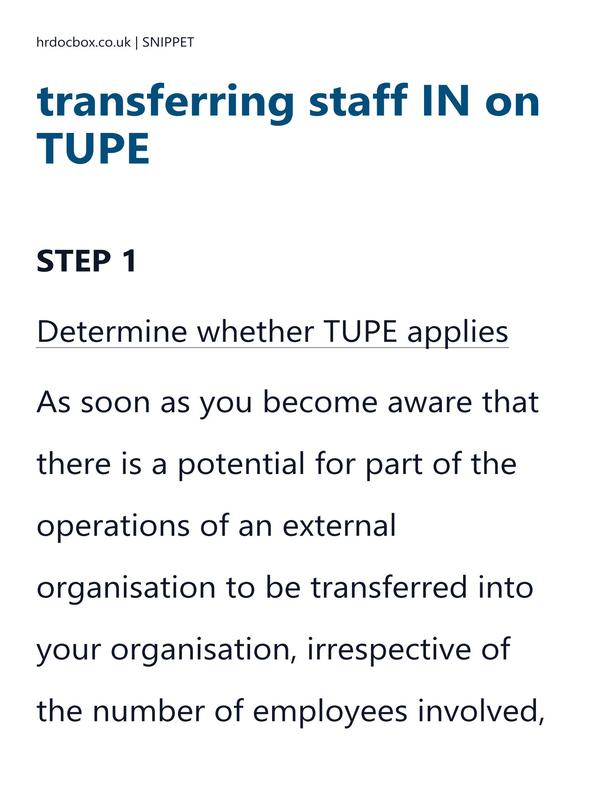Managers guide to transferring staff IN on TUPE


Our Guide to Transferring Staff in on TUPE streamlines the complex process, ensuring compliance and clarity for both incoming and existing employees.
If you are responsible for transferring employees IN to your organisation, this TUPE transfer guide will provide you with a clear, legal, step-by-step process.
- Includes Managers guide to transferring staff IN on TUPE + 15-minute call with an expert.
- UK-specific accuracy. Suitable for use in other territories; check local laws first.
- 12 months’ access, with all updates to this page provided free of charge and notified to you.
- 2,005 words over 5 pages.
- Last updated 16/09/2025.
- Format: Word / PDF / plain text / email.
- Delivery: Instant download after purchase (no physical item).
- Access: Download link shown here after checkout.
- This Managers guide to transferring staff IN on TUPE will SAVE you up to 3 hours research. Save cost. Reduce risk.
Managers guide to transferring staff IN on TUPE
STEP 1
Determine whether TUPE applies
As soon as you become aware that there is a potential for part of the operations of an external organisation to be transferred into your organisation, irrespective of the number of employees involved, you will need to assess whether the transfer will be covered by the TUPE regulations.
This will need to be established early, not only to ensure that all legal duties arising from TUPE are actioned in advance of the transfer taking place, but also to ensure that you gain the confidence and co-operation of the staff that may be transferring.
Seek professional legal advice at this point.
STEP 2
Establish which employees are likely to be transferred
As the new employer, immediately prior to the transfer it will be your duty to take over the contracts of employment of all employees that will transfer. In order to comply with this requirement, you will need to reach agreement with the old employer as to which employees will transfer.
The old employer should provide you with a definitive list of staff that are considered to be affected by the transfer.
| Note
Since April 2006, the
This is a 10% preview of the Managers guide to transferring staff IN on TUPE. For instant full access, purchase this item or a parent bundle.
Managers guide to transferring staff IN on TUPE
The Guide to Transferring Staff in on TUPE provides comprehensive instructions for handling employee transfers under the Transfer of Undertakings (Protection of Employment) Regulations (TUPE).
It outlines the legal obligations and procedural steps involved in ensuring a smooth transition for employees during business transfers, acquisitions, or outsourcing arrangements.
This guide offers practical insights and best practices for HR professionals and business owners to navigate TUPE transfers effectively. By understanding the rights and responsibilities of both employers and employees under TUPE, organisations can mitigate risks, maintain employee morale, and foster a positive transition experience for all parties involved.
It covers the following:
-
Determining whether TUPE applies.
-
Establishing which employees are likely to be transferred.
-
Consulting with representatives.
-
Informing and consulting affected staff.
-
Confirming the transfer.
-
Exchanging employee data.
-
Indemnity.
-
Preparing for transfer day.
-
Induction.
-
Harmonising terms and conditions.
Frequently Asked Questions about a Managers guide to transferring staff IN on TUPE
Frequently Asked Questions about a Managers guide to transferring staff IN on TUPE
-
Can I use this template in my small business?
Yes. The Managers guide to transferring staff IN on TUPE is designed to be flexible and suitable for organisations of all sizes, including small businesses and charities. It follows UK employment law best practice, so even if you don't have an in-house HR team, you can confidently apply it.
-
Is the Managers guide to transferring staff IN on TUPE compliant with 2026 UK employment law?
Absolutely. All of our templates are drafted with the latest ACAS guidance and UK employment legislation in mind. We review and update them regularly, so you can be confident they remain compliant.
-
Can I customise it for my organisation?
Yes, we highlight the areas that you need to update with your own details, and where you need to make decisions to suit your situation. This saves you time and ensures that you meet best practice.
-
Do I get instant access?
Yes. Once purchased, you'll be able to download it instantly. Templates are provided in editable Word or Excel format so you can customise them easily, and in PDF format for easy sharing.
-
What if I need more help, not just this template?
If you're looking for broader support, we also offer toolkits and library bundles that include this template, along with other HR templates and policies for fully managing your situation. These may be more cost-effective if you need deeper advice.
-
Why should I use this, and not AI to generate this template?
The risk of using a free AI-generated template 'without review' includes your legal exposure, missing context, and no awareness of the wider process. Purchasing from us mitigates that risk.
